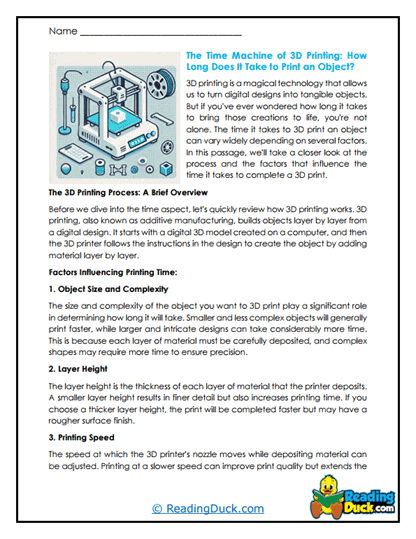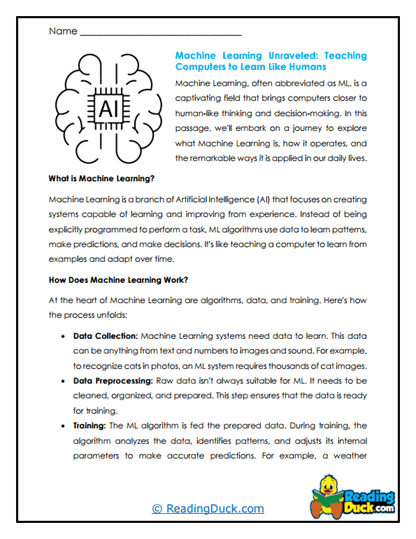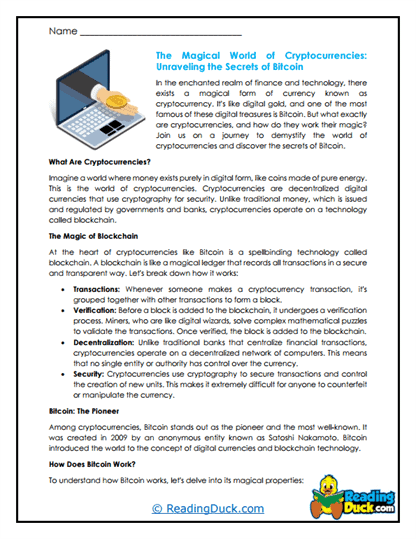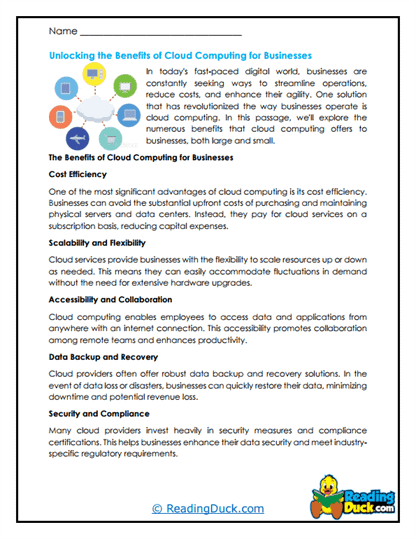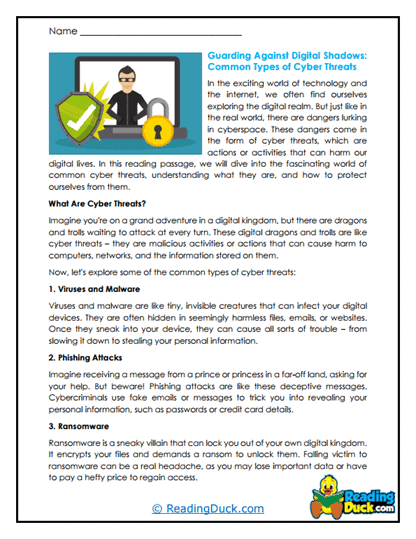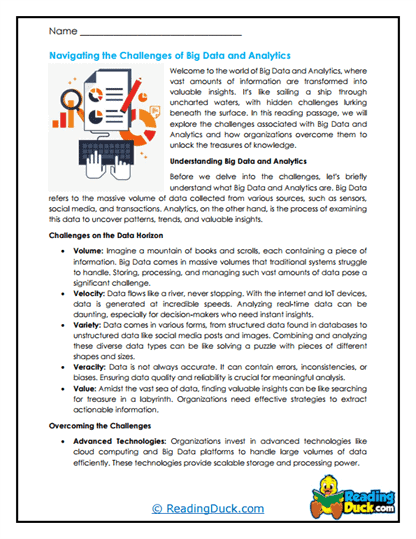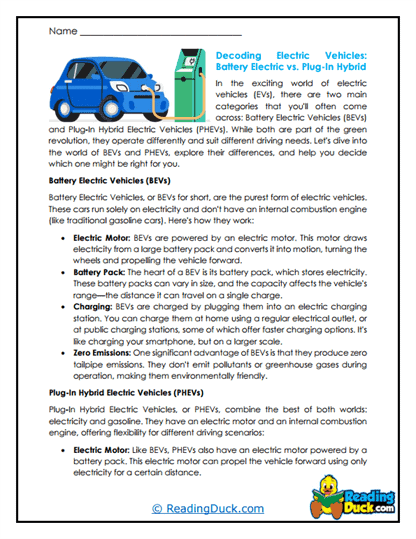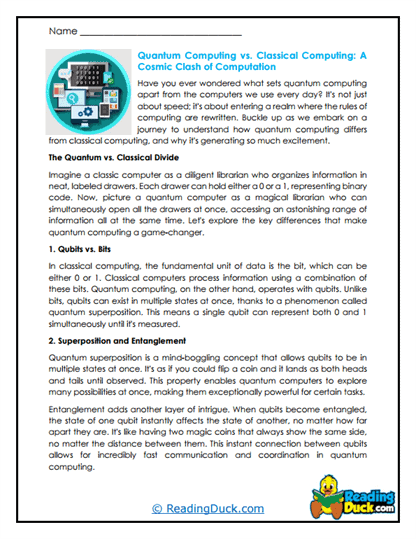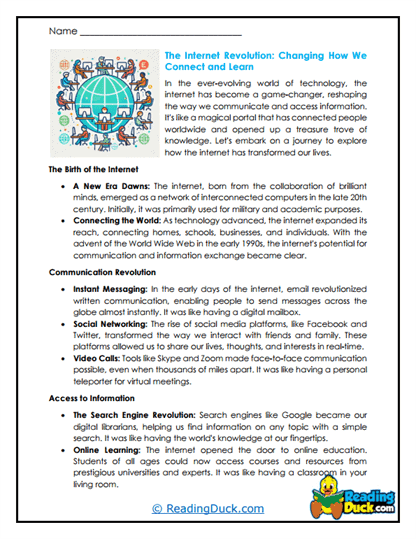Technology Worksheets
About Our Technology Worksheets
Our Technology Reading Comprehension Worksheets are a carefully curated collection designed to bring the world of modern technology into the classroom. These worksheets cover a range of topics that are not only relevant in today’s digital age but also crucial for understanding the technological landscape that shapes our world. The collection is divided into categories such as 3D Printing, Artificial Intelligence, Autonomous Vehicles, Blockchain and Cryptocurrencies, Cloud Computing, Cybersecurity, Data Analytics, Electric Cars, Quantum Computing, and The Internet.
Each of these categories contains multiple worksheet sets that delve into specific aspects of the topic. These worksheet sets are designed to enhance students' understanding and engagement with the material through a variety of question formats. Here’s how each worksheet is structured:
- Multiple Choice Questions: These questions test students' recall and comprehension of key details from the reading passage. They encourage students to think critically about the information presented, helping to solidify their understanding of the topic.
- Short Answer Questions: In this format, students are required to articulate their understanding in their own words. This encourages deeper reflection on the material and helps develop analytical and writing skills.
- Open-Ended Questions: These questions invite students to share their personal opinions, interpretations, and preferences related to the content. This format encourages creativity and allows students to connect with the material on a more personal level.
These varied question formats are designed not only to assess students’ comprehension but also to deepen their engagement with the material. Each worksheet set includes an answer key, making it easier for teachers and parents to guide the learning process. All of the worksheets are available in PDF format, which can be easily viewed electronically, downloaded, and printed out for classroom or home use.
Overview of Topics in This Worksheet Collection
Our Technology Reading Comprehension Worksheets cover a broad range of topics that are at the forefront of technological innovation. Each category was chosen to provide students with a comprehensive understanding of the key areas that are shaping the future. Here’s an overview of the categories included in this collection:
- 3D Printing:
- 3D printing, also known as additive manufacturing, is revolutionizing the way we create and manufacture products. This category explores the basics of 3D printing technology, its applications in various industries, and the potential it holds for the future. Students will learn about the process of 3D printing, from design to production, and how it is transforming fields such as healthcare, automotive, and aerospace.
- Artificial Intelligence:
- Artificial Intelligence (AI) is one of the most exciting and rapidly advancing fields in technology. This category covers the fundamentals of AI, including machine learning, natural language processing, and robotics. Students will explore how AI is being used in everyday life, from virtual assistants to autonomous vehicles, and the ethical considerations surrounding its development and use.
- Autonomous Vehicles:
- Autonomous vehicles, or self-driving cars, are set to change the way we think about transportation. This category delves into the technology behind autonomous vehicles, including sensors, machine learning, and decision-making algorithms. Students will learn about the benefits and challenges of autonomous vehicles, as well as their potential impact on society and the environment.
- Blockchain and Cryptocurrencies:
- Blockchain technology is the foundation of cryptocurrencies like Bitcoin, and it has far-reaching implications beyond digital currencies. This category explains the basics of blockchain technology, how cryptocurrencies work, and the potential applications of blockchain in various industries. Students will gain an understanding of the security, transparency, and decentralization that blockchain offers.
- Cloud Computing:
- Cloud computing has become a fundamental part of modern technology infrastructure. This category explores what cloud computing is, how it works, and its advantages over traditional computing models. Students will learn about the different types of cloud services, such as IaaS, PaaS, and SaaS, and how cloud computing is transforming businesses and personal computing.
- Cybersecurity:
- In a world that is increasingly connected, cybersecurity is more important than ever. This category covers the basics of cybersecurity, including common threats like malware, phishing, and hacking. Students will learn about the strategies and technologies used to protect data and maintain privacy, as well as the importance of ethical hacking and cybersecurity awareness.
- Data Analytics:
- Data analytics is the process of examining large datasets to uncover patterns, correlations, and trends. This category introduces students to the tools and techniques used in data analytics, such as data mining, statistical analysis, and predictive modeling. Students will explore how data analytics is used in business, healthcare, and sports to make informed decisions.
- Electric Cars:
- Electric cars are a key component of the shift towards sustainable transportation. This category explores the technology behind electric vehicles (EVs), including batteries, electric motors, and charging infrastructure. Students will learn about the environmental benefits of electric cars, the challenges of adoption, and the future of electric mobility.
- Quantum Computing:
- Quantum computing is a cutting-edge field that promises to revolutionize computing by harnessing the power of quantum mechanics. This category explains the basics of quantum computing, how it differs from classical computing, and its potential applications. Students will explore the concepts of qubits, superposition, and quantum entanglement, and how quantum computing could solve problems that are currently intractable for classical computers.
- The Internet:
- The Internet is the backbone of the digital world, connecting billions of people and devices around the globe. This category covers the history of the Internet, how it works, and its impact on society. Students will learn about the structure of the Internet, the development of web technologies, and the ongoing challenges related to privacy, security, and digital literacy.
These topics were chosen because they represent some of the most influential and rapidly developing areas in technology. By exploring these categories, students can gain a solid understanding of the technologies that are shaping the future and develop the skills they need to succeed in a technology-driven world.
Why Technology Literacy is Essential for Students
In today’s digital age, understanding technology is no longer optional—it’s essential. Technology literacy equips students with the knowledge and skills they need to navigate and succeed in a rapidly changing world. Here’s why developing technology literacy is so important:
- Prepares Students for the Future:
- Technology is a major part of nearly every industry. By understanding key technological concepts, students are better prepared for future careers in fields such as engineering, IT, healthcare, and more.
- Enhances Problem-Solving Skills:
- Engaging with technology helps students develop critical thinking and problem-solving skills. Understanding how technology works enables students to troubleshoot issues, think creatively, and develop innovative solutions.
- Fosters Digital Citizenship:
- As students increasingly interact online, understanding the ethical and social implications of technology is crucial. Technology literacy includes learning about online safety, privacy, and the responsible use of digital tools.
- Encourages Lifelong Learning:
- Technology is constantly evolving. Developing a strong foundation in technology encourages students to be lifelong learners, continually adapting to new tools and advancements.
- Promotes Collaboration and Communication:
- Many modern technologies are designed to enhance collaboration and communication. By learning about these tools, students can effectively work with others, share ideas, and contribute to global conversations.
How Teachers and Parents Can Integrate These Worksheets in a Learning Curriculum
Integrating Technology Reading Comprehension Worksheets into the curriculum can be a powerful way to enhance students’ understanding of technology while also improving their reading and comprehension skills. Here are some practical tips for teachers and parents:
- Use in Technology or Science Classes:
- Incorporate the worksheets into technology or science lessons to reinforce key concepts and provide students with a deeper understanding of the topics being studied.
- Assign as Homework or Independent Study:
- Assign the worksheets as homework or as part of an independent study project. This allows students to explore technology topics in more depth at their own pace, fostering a deeper understanding of the material.
- Cross-Curricular Connections:
- Connect the technology worksheets to subjects like math, history, or social studies. For example, explore the mathematical algorithms behind data analytics or the historical development of the Internet.
- Group Discussions and Projects:
- Encourage students to work in groups to analyze the reading passages and present their findings to the class. Group projects, such as creating a presentation on the impact of artificial intelligence, can foster collaboration and enhance communication skills.
- Use in STEM Programs:
- Integrate the worksheets into STEM (Science, Technology, Engineering, and Mathematics) programs to help students build a strong foundation in technology and develop the skills needed for success in STEM-related fields.
- Parental Involvement:
- Parents can use the worksheets at home to support their child’s technology education. Discuss the reading passages together, explore additional resources, and engage in family activities that reinforce the concepts being studied.
- Interactive Activities:
- Combine the worksheets with hands-on activities, such as building a simple 3D model or experimenting with basic coding. This hands-on approach can help students apply what they’ve learned and develop practical skills in a fun and engaging way.
Brief Overview of Benefits
Studying technology through these worksheets enhances a range of academic and personal skills. Students develop technology literacy by understanding key concepts, critical thinking through problem-solving exercises, and digital citizenship by learning about the ethical use of technology. Additionally, the worksheets improve reading comprehension and provide opportunities for interdisciplinary learning, making them a valuable addition to any curriculum.
In conclusion, our Technology Reading Comprehension Worksheets offer a comprehensive and engaging way to explore the rapidly evolving world of technology. By integrating these worksheets into the curriculum, teachers and parents can help students gain a deeper understanding of technological concepts while developing essential academic and personal skills. Through a combination of reading, analysis, and hands-on exploration, these worksheets offer students the tools they need to connect with technology on a meaningful level and prepare for future success in a technology-driven world.
